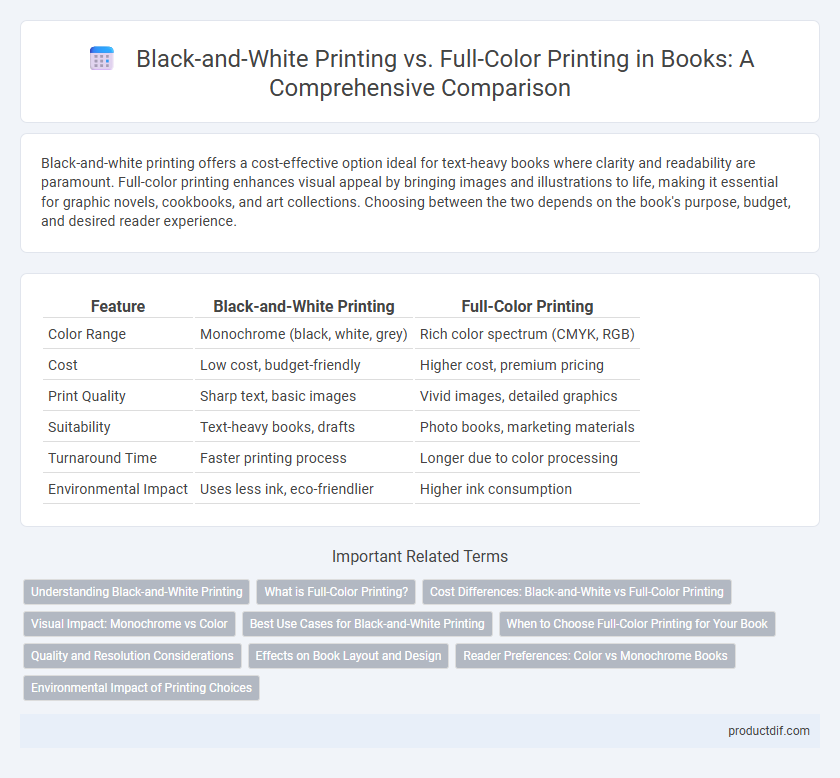Black-and-white printing offers a cost-effective option ideal for text-heavy books where clarity and readability are paramount. Full-color printing enhances visual appeal by bringing images and illustrations to life, making it essential for graphic novels, cookbooks, and art collections. Choosing between the two depends on the book's purpose, budget, and desired reader experience.
Table of Comparison
| Feature | Black-and-White Printing | Full-Color Printing |
|---|---|---|
| Color Range | Monochrome (black, white, grey) | Rich color spectrum (CMYK, RGB) |
| Cost | Low cost, budget-friendly | Higher cost, premium pricing |
| Print Quality | Sharp text, basic images | Vivid images, detailed graphics |
| Suitability | Text-heavy books, drafts | Photo books, marketing materials |
| Turnaround Time | Faster printing process | Longer due to color processing |
| Environmental Impact | Uses less ink, eco-friendlier | Higher ink consumption |
Understanding Black-and-White Printing
Black-and-white printing uses only black ink or toner on white paper, producing high-contrast images ideal for text-heavy documents and simple graphics. This method reduces printing costs and speeds up production, making it a preferred choice for drafts, academic papers, and legal documents. While it limits color nuances, its clarity and efficiency make it indispensable in professional and educational settings.
What is Full-Color Printing?
Full-color printing uses the CMYK color model, blending cyan, magenta, yellow, and black inks to produce vibrant, detailed images and a wide color spectrum in books. This technique enhances visual appeal, making it ideal for photo books, art catalogs, and marketing materials where color accuracy and impact are crucial. The increased production cost compared to black-and-white printing is balanced by the superior quality and reader engagement full-color prints deliver.
Cost Differences: Black-and-White vs Full-Color Printing
Black-and-white printing significantly reduces production costs by using only a single toner or ink, making it ideal for budget-conscious projects such as manuscripts or drafts. Full-color printing involves multiple ink cartridges and complex processes, which substantially increase expenses, often doubling or tripling the cost per page compared to monochrome prints. Businesses and authors frequently choose black-and-white printing for bulk orders to optimize budget efficiency while reserving full-color options for high-impact marketing materials or illustrated books.
Visual Impact: Monochrome vs Color
Black-and-white printing delivers a classic, timeless aesthetic that emphasizes contrast, texture, and form, making it particularly effective for text-heavy books and artistic photography. Full-color printing enhances visual impact by providing vibrant, lifelike images that attract attention and convey emotion through a rich palette, ideal for children's books, cookbooks, and graphic novels. The choice between monochrome and color directly influences reader engagement and the overall perception of the book's content.
Best Use Cases for Black-and-White Printing
Black-and-white printing is ideal for text-heavy documents such as novels, reports, and manuals where clarity and readability are paramount. This printing method significantly reduces production costs, making it suitable for high-volume printing and budget-conscious projects. Additionally, black-and-white printing offers faster turnaround times and is less complex compared to full-color printing, making it perfect for mass distribution of flyers, brochures, and draft materials.
When to Choose Full-Color Printing for Your Book
Full-color printing enhances books with vibrant images, detailed illustrations, and complex designs, making it ideal for art books, children's books, and cookbooks where visual impact is crucial. Choose full-color printing to engage readers through vivid hues and realistic color representation, which black-and-white printing cannot achieve. This option often increases production costs but significantly boosts reader experience and market appeal for visually rich content.
Quality and Resolution Considerations
Black-and-white printing offers sharp contrast and precise detail, making it ideal for text-heavy documents and high-resolution line art, with typical resolutions ranging from 600 to 1200 dpi for crisp output. Full-color printing provides vibrant, accurate color reproduction necessary for photos and graphics, requiring higher resolution settings, often 1200 dpi or more, to ensure smooth gradients and fine detail. Choosing between black-and-white and full-color printing ultimately depends on the quality demands of the content and the desired visual impact in printed books.
Effects on Book Layout and Design
Black-and-white printing significantly impacts book layout by emphasizing typography and contrast, allowing designers to focus on clean lines and structured spacing without the distraction of color. Full-color printing enhances visual storytelling through vibrant images and varied hues, requiring careful consideration of color balance and page composition to maintain readability and aesthetic appeal. Choice between these printing methods influences font selection, image integration, and overall design complexity to match the book's purpose and target audience.
Reader Preferences: Color vs Monochrome Books
Reader preferences for black-and-white printing often favor classic novels, academic texts, and genres where imagery is minimal or monochrome enhances focus, while full-color printing appeals strongly to children's books, graphic novels, and cookbooks where vibrant visuals enhance engagement. Studies show that color images in books can increase comprehension and retention by up to 70%, particularly in educational materials and visual storytelling. However, monochrome books remain popular for their cost-effectiveness, aesthetic simplicity, and reduced eye strain during extended reading sessions.
Environmental Impact of Printing Choices
Black-and-white printing significantly reduces environmental impact by consuming less ink and energy compared to full-color printing, which requires multiple color cartridges and higher energy usage. The production and disposal of color inks often involve more toxic chemicals and generate increased plastic waste. Choosing black-and-white printing supports sustainable practices by minimizing resource consumption and reducing carbon footprint in publishing and printing industries.
Black-and-White Printing vs Full-Color Printing Infographic

 productdif.com
productdif.com